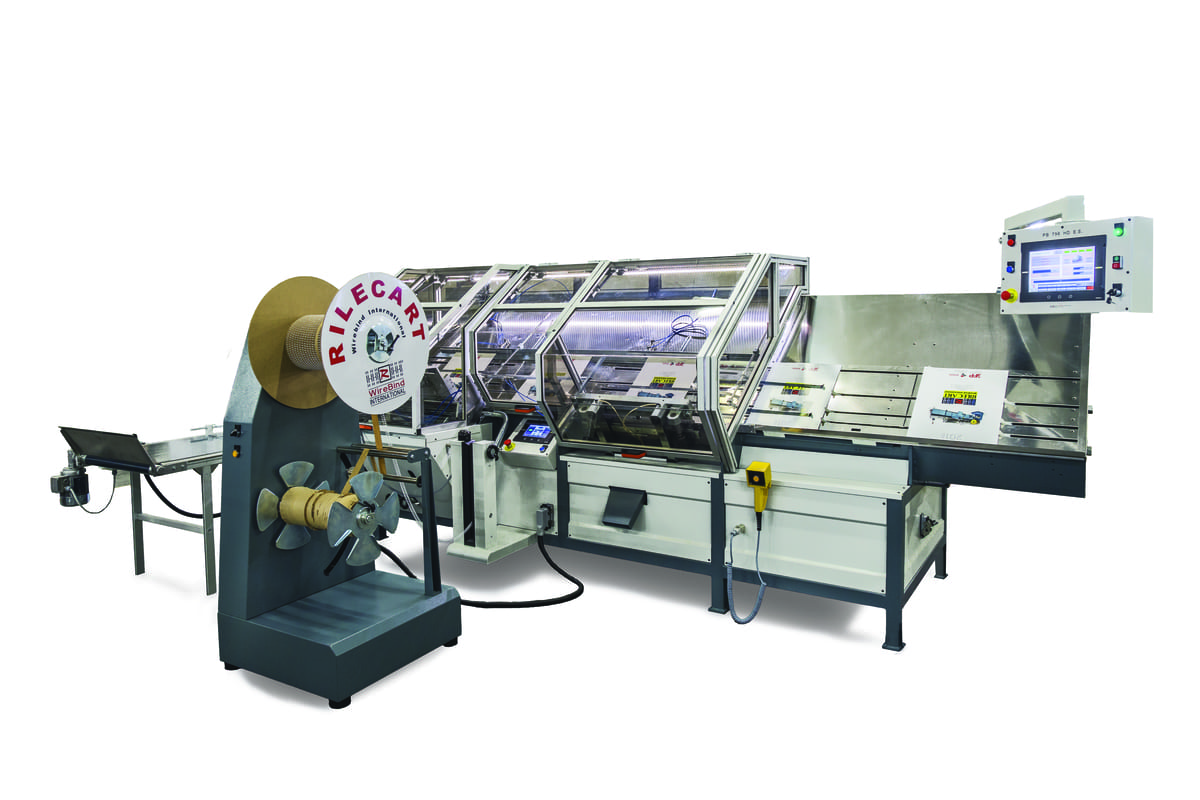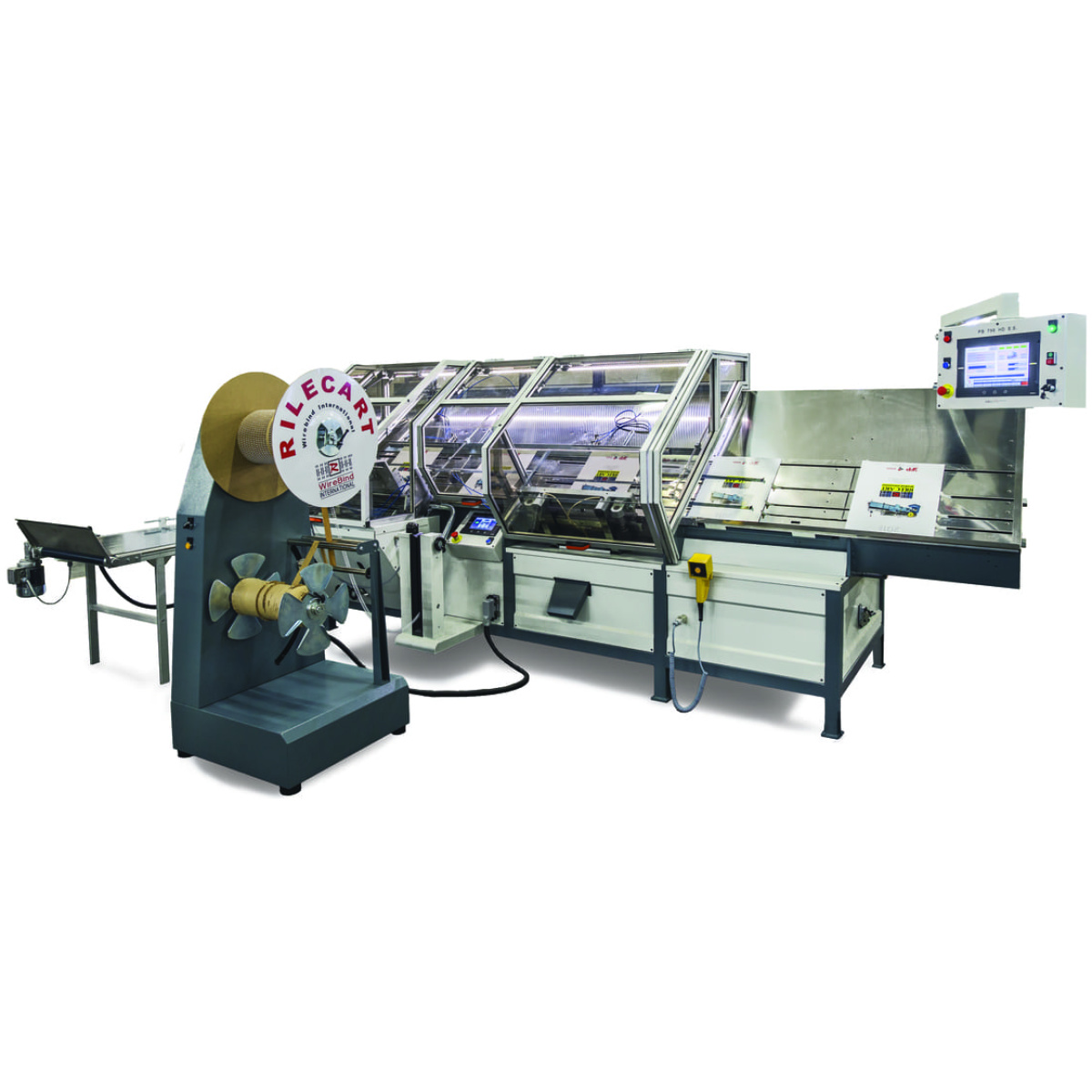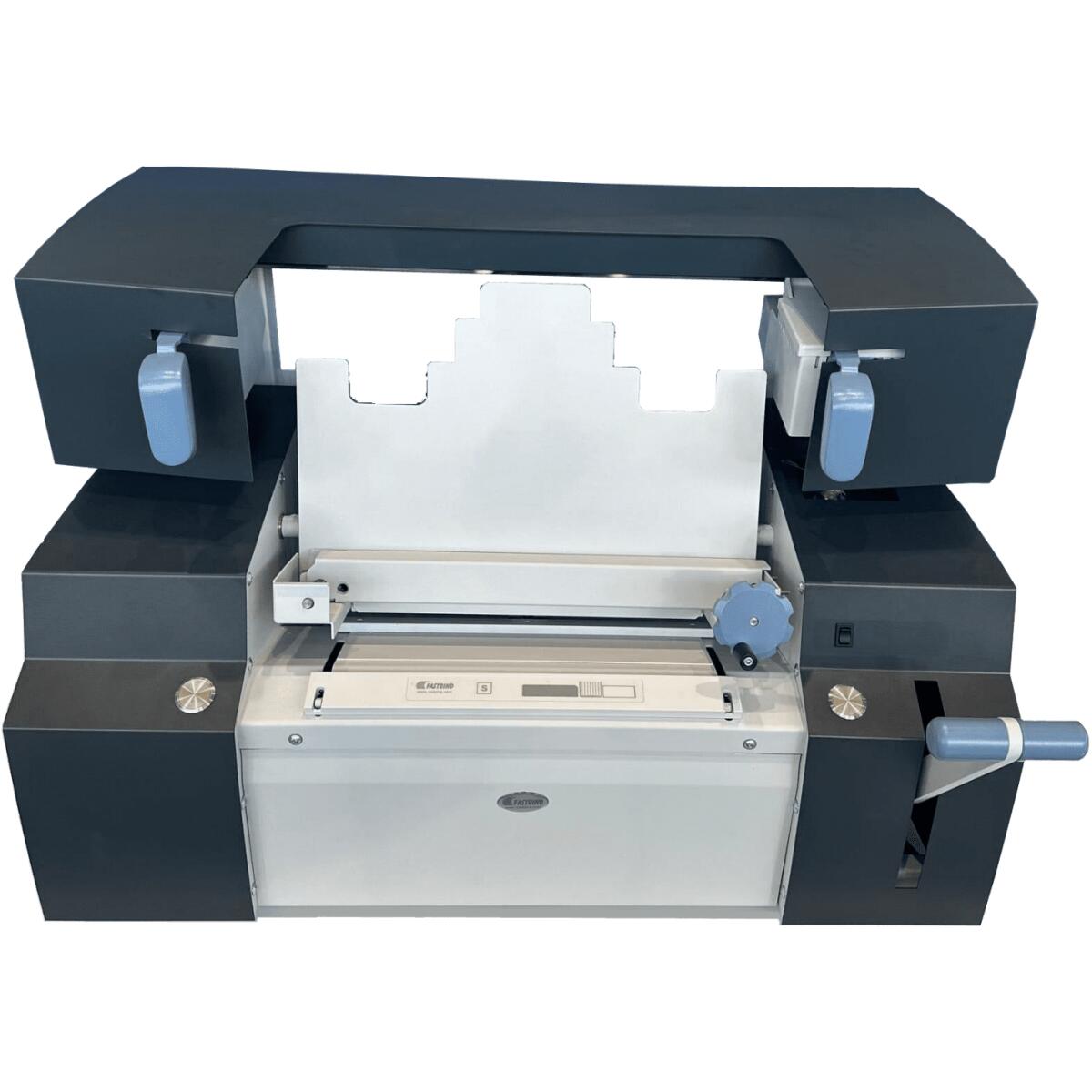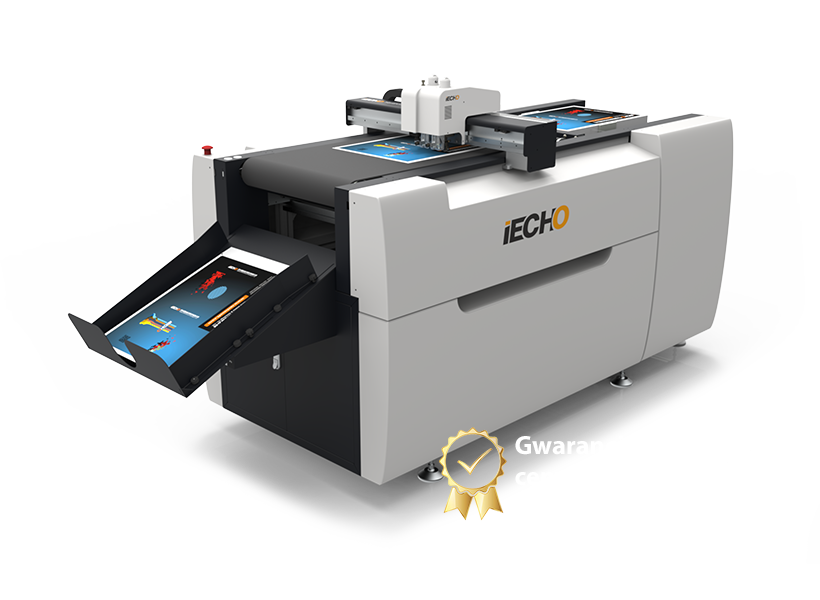Binding what is it? A complete guide to document binding
Bindowanie to profesjonalna technika łączenia luźnych kartek papieru w jedną spójną całość, która stanowi fundament nowoczesnego introligatorstwa. Z łacińskiego „intro” oznaczającego „do środka” oraz „ligare” – „związywać”, termin ten ewoluował od średniowiecznego rzemiosła do współczesnej technologii automatyzacji produkcji. W erze cyfrowej, gdzie dokumenty elektroniczne dominują komunikację biznesową, tradycyjne oprawy zyskują nowy wymiar – stają się narzędziem budowania profesjonalnego wizerunku i efektywnej organizacji dokumentacji firmowej.
Modern printers and printing companies are discovering that binding is not only a way to organize documents, but above all an investment in automating production processes. Modern spiral binding systems, such as the PB-799 HD ES automatic machine offered by Akonda, can bind up to 2,600 calendars per hour, fundamentally changing the economics of producing promotional materials and technical documentation.
What is bindery and why it is revolutionizing bookbinding
Bindowanie dokumentów to proces, który polega na łączeniu pojedynczych kartek w jedną całość za pomocą specjalnych narzędzi. W przeciwieństwie do tradycyjnych metod introligatorskich wymagających skomplikowanych procesów szycia czy klejenia, bindowanie oferuje szybkość, elastyczność i ekonomiczność produkcji. Słowo „bindowanie” w kontekście poligraficznym wywodzi się od angielskiego terminu „binding”, który oznacza dosłownie „wiązanie” lub „oprawianie”.
Kluczową przewagą bindowania jest jego uniwersalność zastosowań. Od prostych dokumentów biurowych, przez materiały szkoleniowe i prezentacje, aż po zaawansowane katalogi produktowe i kalendarze ścienne – każdy rodzaj dokumentacji może zyskać profesjonalną oprawę dostosowaną do specyficznych wymagań użytkowania. Do procesu bindowania niezbędne są bindownice, wykorzystujące mechanizm ręczny lub elektryczny, co pozwala na skalowanie produkcji od pojedynczych egzemplarzy po wielotysięczne nakłady.
Modern bindery is also a response to increasing demands for personalization and short production runs. In the era of digital printing, where each copy can be unique, traditional bindery methods are becoming uneconomical. Binding makes it possible to bind even a single document while maintaining production profitability.
Types of bindings - from classics to innovations
Świat bindowania oferuje różnorodność technologii dopasowanych do każdego typu dokumentacji i skali produkcji. Bindowanie plastikowe grzebieniowe jest jednym z najczęściej stosowanych rodzajów oprawy, ze względu na swoją prostotę i funkcjonalność. System ten pozwala na łączenie do 500 kartek, oferując możliwość późniejszej modyfikacji zawartości – nieocenioną zaletę w przypadku dokumentacji technicznej czy materiałów szkoleniowych.
Spiral (coil) binding represents another level of functionality. In addition, a huge advantage of spiral binding is the ability to turn the pages 360 degrees, making this method ideal for calendars, notebooks and presentations that require full unfolding. Metal or plastic spirals are available in a wide range of colors, allowing you to match the aesthetics to your brand identity.
Thermobinding Is distinguished by its elegance and simplicity of execution. The sheets should be evenly arranged in the selected cover, and everything should be placed in the binding machine. Later, along the back of the file, you need to spread glue, which will heat up and thus glue everything together. This method, often required for the binding of theses, provides a professional appearance similar to publishing books.
Channel binding offers a compromise between aesthetics and functionality, using special clamping channels. This system is particularly suitable for design documentation and presentation materials, where speed of binding while maintaining an elegant appearance is important.
Automation technology - the key to efficiency
The real revolution in binding came with process automation. The PB-799 HD ES spiral binding machine, Akonda's flagship product, illustrates the scale of this transformation. The machine is specifically designed to handle large formats with the ability to bind two calendars simultaneously, achieving efficiencies unattainable by traditional methods.
The automatic binding process eliminates the most time-consuming production steps. The machine independently punches the entire calendar in one stroke, automatically inserts the hangers and wire, and then transfers everything to the closing section. With a maximum binding format of 800 x 1000 mm and the ability to process calendars up to 4.5 mm thick, this system opens up new production possibilities.
Kluczowe parametry techniczne automatów spiralujących definiują ich zastosowanie w różnych segmentach rynku. Standardowe średnice opraw od 3/16″ do 3/8″ pokrywają pełne spektrum potrzeb – od cienkich broszur po obszerne katalogi. Możliwość programowania na ciągłą oprawę, oprawę dwóch sztuk z zawieszką lub tryb „skip-binding” zapewnia elastyczność dostosowania do specyfiki produkcji.
The economics of binding in printing practice
Inwestycja w profesjonalne systemy bindowania przynosi wymierne korzyści ekonomiczne. Analiza kosztów pokazuje, że przy produkcji powyżej 500 egzemplarzy miesięcznie, automat spiralujący zwraca się w okresie 12-18 miesięcy. Oszczędności wynikają nie tylko z redukcji kosztów pracy – jeden operator zastępuje zespół 3-4 osób – ale także z minimalizacji odpadów i możliwości realizacji zleceń ekspresowych.
Binding also opens up new market segments. Production of corporate calendars, often seasonal and requiring a high degree of flexibility, is becoming profitable even with small print runs. Personalization of each copy, impossible with traditional offset printing methods, combined with digital printing and automatic binding creates a unique value proposition.
Koszty materiałów eksploatacyjnych pozostają przewidywalne i konkurencyjne. Druty na szpulach, wykorzystywane w automatach spiralujących, kosztują ułamek ceny gotowych spiral, przy jednoczesnym wyeliminowaniu problemu magazynowania różnych rozmiarów. Elastyczność w doborze materiałów – od standardowych drutów po specjalistyczne spirale powlekane – pozwala na optymalizację kosztów w zależności od wymagań projektu.
Industry applications - from office to industry
The versatility of binding makes it applicable in almost every industry. Education sector uses bindery to produce teaching materials, scripts and theses. The ability to quickly update content while maintaining a professional appearance makes this method indispensable in a dynamic academic environment.
Advertising and marketing industry appreciates binding for its ability to create eye-catching presentations and product catalogs. Spiral-bound portfolios, color swatches or material templates combine functionality with aesthetics, reinforcing the marketing message. Automation of the process allows campaigns requiring thousands of personalized materials.
Industry and construction They focus on the durability and resilience of the bindings. Technical documentation, service manuals or construction plans in spiral binding will survive the harsh conditions of use on the construction site or in the workshop. The ability to fully unfold the document makes it easier to work in the field.
One Handy wrapping machine - a compact solution for the demanding
Uzupełnieniem systemów spiralujących w ofercie Akonda jest oklejarka Fastbind One Handy – urządzenie łączące kompaktowość z profesjonalną jakością bindowania książkowego. To innowacyjne rozwiązanie dedykowane jest drukarniom i biurom poszukującym wszechstronności w ograniczonej przestrzeni roboczej.
The use of EVA adhesive in the binding process ensures cost-effectiveness while maintaining high binding quality. The heating and binding system allows for orders ranging from single copies to medium print runs, making the device ideal for companies serving a diverse clientele. The intuitive user interface means that operation requires no specialized training.
Fastbind One Handy is used in the production of photo albums, where the quality of binding is crucial for the presentation of photos. Creating promotional materials in small runs becomes cost-effective, opening up new business opportunities for digital printers.
The future of binding - trends and innovations
The development of bindery technology follows Industry 4.0 trends. Integration of systems with production management software allows full automation of the process from order receipt to shipment. Remote assistance modules, standard on modern equipment, minimize downtime and optimize machine utilization.
Ekologia staje się coraz ważniejszym aspektem wyboru technologii. Bindowanie, w przeciwieństwie do tradycyjnych metod wykorzystujących kleje rozpuszczalnikowe, oferuje rozwiązania przyjazne środowisku. Możliwość łatwego recyklingu oprawionych dokumentów – poprzez oddzielenie spiral metalowych od papieru – wpisuje się w zasady gospodarki obiegu zamkniętego.
Personalization and on-demand production are defining the future of the printing market. Binding, with its flexibility and scalability, is ideally suited to meet these challenges. The ability to produce a single, personalized copy while maintaining process economics opens up new business models based on the long tail of sales.
Summary - bindings as a development strategy
Binding has ceased to be just a bookbinding technique, becoming a strategic tool for the development of printing companies. Investment in modern automation systems, such as the spiral binding machines and binders offered by Akonda, is not only an improvement in production efficiency, but above all an opening to new market segments and business models.
The choice of the right binding technology should take into account not only current needs, but also the company's growth plans. The modularity and scalability of modern systems allows for gradual expansion of production capabilities as the business grows. Technical support and training offered by suppliers such as Akonda minimize the risk of investment and accelerate the return on invested capital.
W erze, gdzie szybkość realizacji i personalizacja stają się kluczowymi przewagami konkurencyjnymi, bindowanie oferuje odpowiedź na wyzwania współczesnego rynku poligraficznego. Od małych biur po duże drukarnie przemysłowe – każdy znajdzie rozwiązanie dopasowane do swoich potrzeb i ambicji rozwojowych.




